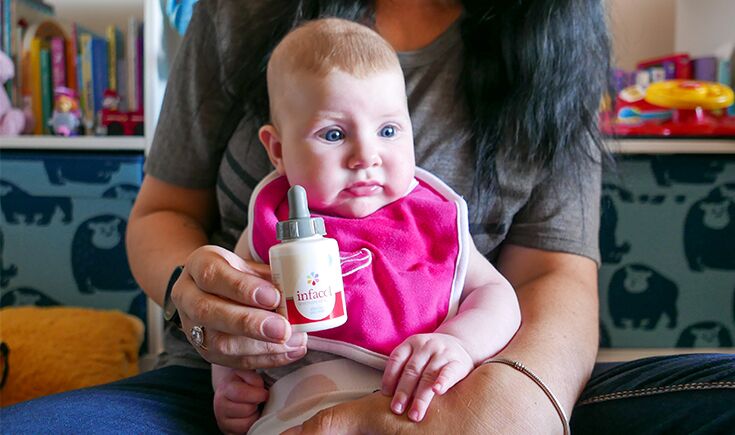How to Stop Baby Waking for Dummy at Night: Expert Tips
To stop a baby from waking for a dummy at night, gradually reduce the use of the dummy when settling your child during the night, as well as for comforting during the day. Offer the dummy every second time your baby cries during the night on the second day, then every third time on the third day, and so on.
This will help your baby gradually become less dependent on the dummy for sleep. If your baby relies on a dummy to fall asleep and keeps waking up in the night to have it replaced, you may be wondering how to break this pattern.
While dummies can provide comfort for babies, constant reliance on them can lead to disrupted sleep for both the baby and parents. We will discuss strategies on how to stop a baby from waking for a dummy at night. By gradually reducing the use of the dummy during the night and finding alternative soothing techniques, you can help your baby develop healthy sleep habits and ensure uninterrupted sleep for everyone.
Establishing A Bedtime Routine
One of the most effective ways to stop baby waking for a dummy at night is to establish a consistent bedtime routine. Babies thrive on routine and predictability, and having a structured bedtime routine can help signal to your little one that it’s time to wind down and prepare for sleep. Consistency is key in creating a bedtime routine, so try to stick to the same activities and timings every night. Here are a few tips to help you establish a successful bedtime routine:
Consistency Is Key In Creating A Bedtime Routine
Consistency plays a crucial role in creating a bedtime routine for your baby. Keeping a consistent schedule helps your baby’s body clock establish a natural sleep-wake cycle, making it easier for them to fall asleep and stay asleep throughout the night. When creating a bedtime routine, choose specific activities and timings that work best for your baby and ensure that they are followed every night. Consistency will provide a sense of security and predictability for your little one, promoting better sleep patterns.
Introduce Calming Activities Before Bed, Such As A Warm Bath Or Reading A Book
As part of the bedtime routine, it’s important to introduce calming activities that can help your baby relax and unwind before sleep. A warm bath can be an excellent way to soothe and relax your little one, making them feel sleepy and ready for bed. Reading a book together can also be a wonderful bonding experience and help your baby associate books with sleep. Choose age-appropriate books with soothing and gentle stories that can lull your baby into a peaceful slumber.
Avoid Stimulating Activities Or Screens Close To Bedtime
It’s crucial to avoid stimulating activities or screens close to bedtime, as they can interfere with your baby’s ability to fall asleep. The blue light emitted by screens, such as televisions, tablets, and smartphones, can suppress the production of melatonin, the hormone that signals sleep. Instead, focus on creating a calm and quiet environment in the hour leading up to bedtime. Dim the lights, play soft and soothing music, and engage in relaxing activities with your baby to help them wind down and prepare for sleep.
Gradual Reduction Of Dummy Dependency
Gradually reduce your baby’s dependency on the dummy by using it less when resettling them at night and during the day. This gradual approach can help your baby learn to sleep without the dummy and prevent them from waking up for it at night.
Start By Gradually Reducing The Use Of The Dummy During The Day
One effective way to help your baby stop waking for the dummy at night is by gradually reducing their dependency on it during the day. This process allows them to get used to the decreased reliance on the dummy and prepares them for the eventual elimination of it during nighttime.
Start by offering the dummy to your baby only during specific times of the day when they really need it, such as during nap times or when they are particularly fussy. This helps create a distinction between when the dummy is necessary and when it is not.
Throughout the day, gradually reduce the number of times you offer the dummy to your baby. For example, if you used to give it to them every time they cried, start giving it to them every other time instead. This incremental reduction helps them gradually transition away from the constant need for the dummy.
Offer Alternative Soothing Techniques, Such As A Soft Toy Or Gentle Music
As you gradually reduce the use of the dummy, it’s important to offer alternative soothing techniques to help your baby feel comforted and fall back to sleep. One great alternative is to introduce a soft toy that they can cuddle with. This provides a similar sense of security that the dummy offers.
Choose a soft toy that is safe for your baby to sleep with, such as a plush animal or a cuddly blanket. Make sure to select one that is appropriate for their age and does not pose any choking hazards.
In addition to a soft toy, you can also try playing gentle music or white noise in the background. This can create a soothing environment and help drown out any external noises that may disrupt your baby’s sleep.
Experiment with different types of music or sounds to find what works best for your baby. Some babies may prefer calming classical music, while others may find nature sounds or lullabies more comforting.
Remember, the goal is to gradually replace the dependency on the dummy with these soothing alternatives.
Slowly Eliminate The Dummy During Nap Times Before Tackling Nighttime Use
Once your baby has adjusted to the reduced use of the dummy during the day and has become comfortable with the alternative soothing techniques, you can start eliminating the dummy during nap times.
Choose a naptime when your baby is typically less reliant on the dummy, such as the mid-morning or mid-afternoon nap. This reduces the chances of them becoming too distressed without it.
During this naptime, offer the soft toy or play soothing music instead of giving them the dummy. This helps them associate these alternative techniques with sleep and relaxation.
If your baby has difficulty settling without the dummy during naptime, be patient and offer reassurance. It may take some time for them to adjust, but with consistency, they will learn to fall asleep without it.
Once your baby is successfully sleeping without the dummy during nap times, you can then work on gradually eliminating it during nighttime as well. This gradual approach ensures that your baby feels secure and comforted throughout the transition.
Implementing Self-soothing Techniques
To stop your baby from waking for a dummy at night, try implementing self-soothing techniques. Gradually reduce the use of the dummy during nighttime settling and comforting, distracting your baby with alternative activities like reading books or establishing a bedtime routine.
Teach Your Baby To Self-settle Without Relying On The Dummy For Comfort
Teaching your baby to self-settle without relying on the dummy for comfort is an important step in helping them sleep through the night. By gradually reducing their dependency on the dummy, you can teach them to soothe themselves back to sleep without needing external help. This process may take time and patience, but it can be a rewarding experience for both you and your baby. Here are some tips to help you successfully implement self-settling techniques:
Encourage Self-soothing Through Techniques Like Gentle Patting Or Shushing
One effective way to encourage self-soothing is by using gentle patting or shushing techniques. This involves comforting your baby without the use of the dummy. When your baby wakes up at night, gently pat their back or bottom while softly shushing them. This physical touch and soothing sound can help them relax and fall back to sleep on their own. It’s important to be consistent with these techniques and provide reassurance to your baby without relying on the dummy.
Be Patient And Consistent In Helping Your Baby Develop Self-soothing Skills
Developing self-soothing skills takes time and consistency. It is important to be patient with your baby as they learn to soothe themselves without the dummy. Provide them with a calm and soothing environment during bedtime and be consistent with your approach. Stick to the techniques you have chosen and give your baby the opportunity to practice self-soothing every time they wake up. With time, they will become more comfortable and confident in soothing themselves back to sleep.
Creating A Soothing Sleep Environment
To stop your baby from waking for a dummy at night, gradually use the dummy less when re-settling them during the night. For example, give the dummy every second time they cry in the night on the second day, then every third time on the third day, and so on.
This will help them become more independent from the dummy and sleep more soundly.
Creating a soothing sleep environment is crucial for helping your baby stay asleep without the need for a dummy at night. By ensuring that the bedroom is quiet, dark, and at an optimal temperature for sleep, you can promote a restful night’s sleep for your little one. Additionally, using white noise machines or soothing lullabies can create a calming atmosphere that helps your baby relax and fall asleep easier. Consider utilizing blackout curtains to eliminate any disruptive lights, ensuring a peaceful sleep environment. Let’s explore these strategies in more detail.Ensure The Bedroom Is Quiet, Dark, And At An Optimal Temperature For Sleep
To create a sleep environment that promotes uninterrupted rest, it’s important to focus on three key factors: quietness, darkness, and optimal temperature. Here are some tips to achieve this: – Keep the bedroom as quiet as possible during nighttime hours. This can be achieved by using a white noise machine or turning on a fan to drown out any external noises that may disturb your baby’s sleep. – Ensure that the room is dark by using blackout curtains or blinds to block out any light. This can help regulate your baby’s melatonin production, a hormone that promotes sleepiness. – Pay attention to the temperature in the room. Ideally, the bedroom should be kept at a slightly cooler temperature, around 68 to 72 degrees Fahrenheit (20 to 22 degrees Celsius), as this is optimal for promoting sleep. Use a reliable thermostat or a room thermometer to monitor the temperature and make necessary adjustments.Use White Noise Machines Or Soothing Lullabies To Create A Calming Atmosphere
White noise machines and soothing lullabies can work wonders when it comes to creating a calming atmosphere that promotes better sleep for your baby. Here’s how you can utilize these tools effectively: – Invest in a high-quality white noise machine that emits soothing sounds, such as ocean waves or raindrops, that mimic the sounds your baby heard in the womb. Place the machine near your baby’s crib, ensuring that it’s at a safe distance. – Alternatively, you can use soft and gentle lullabies to create a soothing environment. Opt for instrumental versions that are specifically designed to promote relaxation and sleep. You can play these lullabies using a baby sleep sound machine or through a speaker connected to your mobile device. – Experiment with different sound options to find the most soothing and comforting for your baby. Every baby is unique, so it may take some trial and error to find the perfect sound that helps your little one relax and fall asleep easily. By incorporating white noise machines or soothing lullabies into your baby’s bedtime routine, you can create a calm and peaceful atmosphere that signals it’s time to sleep.Consider Using Blackout Curtains To Eliminate Any Disruptive Lights
Light exposure can interfere with your baby’s sleep patterns, stimulating wakefulness and making it harder for them to settle down. To combat this, consider using blackout curtains in your baby’s bedroom. These curtains are specifically designed to block out external light sources, creating a darker sleep environment that promotes better sleep. When selecting blackout curtains, opt for ones that are made of thicker, light-blocking materials and are long enough to cover the entire window. Ensure that the curtains are properly installed to minimize any gaps that may allow light to seep in. By eliminating disruptive lights, you can help your baby maintain a more restful and uninterrupted sleep throughout the night. In conclusion, creating a soothing sleep environment is key to stopping your baby from waking up for a dummy at night. Ensure the bedroom is quiet, dark, and at an optimal temperature for sleep. Use white noise machines or soothing lullabies to create a calming atmosphere. Additionally, consider using blackout curtains to eliminate any disruptive lights. By implementing these strategies, you can help your little one sleep soundly without relying on a dummy.Addressing Sleep Regressions And Night Wakings
To address sleep regressions and night wakings, try gradually phasing out the dummy by using it less when resettling your child during the night and for comforting during the day. You can also try alternative methods such as reading books or implementing a bedtime routine to distract your baby from wanting the dummy.
Sleep regressions and night wakings can be challenging for both babies and parents. It’s important to understand that these are normal and temporary phases that many babies go through as they continue to develop and grow. As a parent, there are steps you can take to address these issues and help your baby sleep more soundly throughout the night. In this section, we will explore how to navigate sleep regressions, offer extra comfort and reassurance to your baby, and highlight when it may be necessary to consult a pediatrician for further guidance.
Understand That Sleep Regressions Are Normal And Temporary Phases
One of the key things to remember during sleep regressions is that they are completely normal and usually temporary. Babies go through various developmental leaps, such as growth spurts, teething, or learning new skills, which can disrupt their sleep patterns. These regressions can occur at different stages, typically around 4 months, 6 months, and beyond.
It’s important not to panic or feel discouraged when your baby’s sleep routine is disrupted. Remember, this phase is temporary and your baby will eventually adjust and settle back into a more regular sleep pattern.
During Regressions, Offer Extra Comfort And Reassurance To Help Your Baby Through
When your baby is experiencing a sleep regression, providing extra comfort and reassurance can make a big difference. This can help them feel more secure and calm during the night, increasing the chances of them falling back asleep on their own.
Here are a few strategies you can try:
- Offering extra cuddles and soothing touches before putting your baby back to bed.
- Using gentle white noise or a lullaby to help create a calming sleep environment.
- Implementing a consistent bedtime routine to signal to your baby that it’s time to sleep.
- Ensuring your baby’s sleep environment is comfortable, with the right temperature and lighting.
Remember, every baby is unique, so it may take some trial and error to find the best methods that work for your little one. Be patient and flexible, and trust your instincts as a parent.
If Night Wakings Persist, Consult A Pediatrician For Further Guidance
In some cases, despite your best efforts, night wakings may continue persistently. If this is the case, it might be beneficial to consult a pediatrician for further guidance. They can provide personalized advice based on your baby’s specific needs and help rule out any underlying medical conditions that could be contributing to the night wakings.
Additionally, a pediatrician can offer recommendations for sleep training techniques or suggest resources to help you navigate this phase effectively. Remember, seeking professional guidance can bring you peace of mind and ensure that you are taking the necessary steps to support your baby’s sleep and overall well-being.

Credit: www.cnn.com
Frequently Asked Questions On How To Stop Baby Waking For Dummy At Night
How Do I Stop My Baby From Pulling His Dummy Out At Night?
To stop your baby from pulling out their dummy at night, gradually reduce their dependence on it. Use the dummy less when resettling your baby during the night and for comforting during the day. This will help them become more independent from the dummy.
How Do I Get My Baby To Stop Crying For The Pacifier At Night?
To stop your baby from crying for the pacifier at night, gradually reduce its use for resettling during the night and comforting during the day. Instead of putting the pacifier in their mouth, give it to them to hold in their hand or both hands.
This helps them learn dummy independence.
How Do I Teach My Baby To Self Settle Without A Dummy?
To teach your baby to self-settle without a dummy, gradually use the dummy less during the night and for comforting during the day. You can also try other soothing techniques like reading books or establishing a simple bedtime routine. Remember to be patient and consistent.
Why Does My Baby Wake Up Every Time The Pacifier Falls Out?
Babies may wake up when the pacifier falls out because they have become reliant on it for sleep. When the pacifier is removed, they may need to learn how to fall asleep without it, causing them to wake up or cry.
Gradually reducing pacifier use during sleep may help.
Conclusion
To help your baby stop waking for the dummy at night, gradually reduce their dependency on it. Try using the dummy less when resettling your child during the night, and also limit its use for comforting during the day. Encourage dummy independence by guiding your baby’s hand to find the dummy themselves when they wake up.
Implementing these steps will help your baby learn to self-settle without relying on the dummy.








